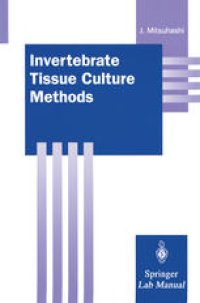
Ebook: Invertebrate Tissue Culture Methods
Author: Jun Mitsuhashi (auth.)
- Tags: Cell Biology, Zoology
- Series: Springer Lab Manual
- Year: 2002
- Publisher: Springer Japan
- Edition: 1
- Language: English
- pdf
I started insect cell culture work in 1962, when T. D. C. Grace reported the first establishment of invertebrate continuous cell lines. He obtained grow ing cells from pupal ovaries of the emperor gum moth, Antheraea euca lypti. At that time, I was trying to obtain growing cells from leafhoppers. Grace's method could not be applied directly to my culture because of the differences in species, the size of the insects, and the tissue to be cul tured. The vertebrate tissue culture methods gave me some ideas for pre paring cultures from leafhoppers, but those could not be used directly either. There were no textbooks and no manuals for invertebrate tissue culture, so I had to develop a method by myself. First, I considered what type and what size of vessels are suitable for insect tissue culture. Also, I had to look for suitable materials to construct the culture vessels. Sec ond, I had to examine various culture media, especially growth-promot ing substances, such as sera. Then I had to improve culture media by trial and error. The procedure to set up a primary culture was also a problem. How could I sterilize materials? How could I remove tissues from a tiny insect? How many tissues should I pool in order to set up one culture? I had to find out the answers. Naturally, it took a lot of time.
The techniques for establishing and maintaining invertebrate tissues and cells in culture remain difficult due to the diversity of invertebrates and their structural and physiological characteristics. Research involving invertebrate cell cultures continues to increase, although the number of cell lines used is still limited. This manual gives detailed descriptions of the technical procedures for the establishment of primary invertebrate cell cultures in vitro. Nutritional requirements, culture media, and species-specific methods for both cell and organ cultures as well as useful techniques for studies on cultured cells are described. The Appendix lists established cell lines available for research with information on the composition of their physiological and nutrient solutions. This comprehensive manual, the first of its kind, is a valuable reference for investigators working with invertebrate cell cultures in academia and industry.
The techniques for establishing and maintaining invertebrate tissues and cells in culture remain difficult due to the diversity of invertebrates and their structural and physiological characteristics. Research involving invertebrate cell cultures continues to increase, although the number of cell lines used is still limited. This manual gives detailed descriptions of the technical procedures for the establishment of primary invertebrate cell cultures in vitro. Nutritional requirements, culture media, and species-specific methods for both cell and organ cultures as well as useful techniques for studies on cultured cells are described. The Appendix lists established cell lines available for research with information on the composition of their physiological and nutrient solutions. This comprehensive manual, the first of its kind, is a valuable reference for investigators working with invertebrate cell cultures in academia and industry.
Content:
Front Matter....Pages I-XVI
Front Matter....Pages 1-1
Facilities and Equipment....Pages 3-14
Basic Information and Overview....Pages 15-24
Preparation of Media....Pages 25-32
General Cell Culture Methods....Pages 33-44
Front Matter....Pages 45-45
Insecta (Lepidoptera)....Pages 47-71
Insecta (Diptera)....Pages 73-86
Insecta (Coleoptera)....Pages 87-90
Insecta (Hemiptera)....Pages 91-99
Insecta (Hymenoptera)....Pages 101-105
Insecta (Blattaria)....Pages 107-115
Insecta (Orthoptera)....Pages 117-120
Arthropods Other Than Insects....Pages 121-141
Prochordata....Pages 143-151
Echinodermata....Pages 153-160
Mollusca....Pages 161-195
Annelida....Pages 197-201
Nematoda....Pages 203-207
Platyhelminthes....Pages 209-219
Coelenterata....Pages 221-229
Porifera....Pages 231-236
Front Matter....Pages 237-237
Insecta....Pages 239-268
Arthropoda Other Than Insecta....Pages 269-278
Prochordata....Pages 279-279
Echinodermata....Pages 281-282
Mollusca....Pages 283-285
Annelida....Pages 287-292
Nematoda....Pages 293-294
Platyhelminthes....Pages 295-297
Coelenterata....Pages 299-302
Porifera....Pages 303-303
Front Matter....Pages 305-305
Cell Cloning....Pages 307-319
Karyotype Analysis....Pages 321-323
Identification of Cell Lines....Pages 325-335
Viability of Cells....Pages 337-340
Viable Cell Enumeration....Pages 341-345
Growth Rate....Pages 347-351
Microscope Photography....Pages 353-355
Virus Inoculation-Plaque Assay....Pages 357-365
Examination of Drug Effects....Pages 367-368
Cell Fusion....Pages 369-377
Front Matter....Pages 305-305
Gene Technology....Pages 379-386
Large-Scale Cell Culture....Pages 387-400
Back Matter....Pages 401-446
The techniques for establishing and maintaining invertebrate tissues and cells in culture remain difficult due to the diversity of invertebrates and their structural and physiological characteristics. Research involving invertebrate cell cultures continues to increase, although the number of cell lines used is still limited. This manual gives detailed descriptions of the technical procedures for the establishment of primary invertebrate cell cultures in vitro. Nutritional requirements, culture media, and species-specific methods for both cell and organ cultures as well as useful techniques for studies on cultured cells are described. The Appendix lists established cell lines available for research with information on the composition of their physiological and nutrient solutions. This comprehensive manual, the first of its kind, is a valuable reference for investigators working with invertebrate cell cultures in academia and industry.
Content:
Front Matter....Pages I-XVI
Front Matter....Pages 1-1
Facilities and Equipment....Pages 3-14
Basic Information and Overview....Pages 15-24
Preparation of Media....Pages 25-32
General Cell Culture Methods....Pages 33-44
Front Matter....Pages 45-45
Insecta (Lepidoptera)....Pages 47-71
Insecta (Diptera)....Pages 73-86
Insecta (Coleoptera)....Pages 87-90
Insecta (Hemiptera)....Pages 91-99
Insecta (Hymenoptera)....Pages 101-105
Insecta (Blattaria)....Pages 107-115
Insecta (Orthoptera)....Pages 117-120
Arthropods Other Than Insects....Pages 121-141
Prochordata....Pages 143-151
Echinodermata....Pages 153-160
Mollusca....Pages 161-195
Annelida....Pages 197-201
Nematoda....Pages 203-207
Platyhelminthes....Pages 209-219
Coelenterata....Pages 221-229
Porifera....Pages 231-236
Front Matter....Pages 237-237
Insecta....Pages 239-268
Arthropoda Other Than Insecta....Pages 269-278
Prochordata....Pages 279-279
Echinodermata....Pages 281-282
Mollusca....Pages 283-285
Annelida....Pages 287-292
Nematoda....Pages 293-294
Platyhelminthes....Pages 295-297
Coelenterata....Pages 299-302
Porifera....Pages 303-303
Front Matter....Pages 305-305
Cell Cloning....Pages 307-319
Karyotype Analysis....Pages 321-323
Identification of Cell Lines....Pages 325-335
Viability of Cells....Pages 337-340
Viable Cell Enumeration....Pages 341-345
Growth Rate....Pages 347-351
Microscope Photography....Pages 353-355
Virus Inoculation-Plaque Assay....Pages 357-365
Examination of Drug Effects....Pages 367-368
Cell Fusion....Pages 369-377
Front Matter....Pages 305-305
Gene Technology....Pages 379-386
Large-Scale Cell Culture....Pages 387-400
Back Matter....Pages 401-446
....